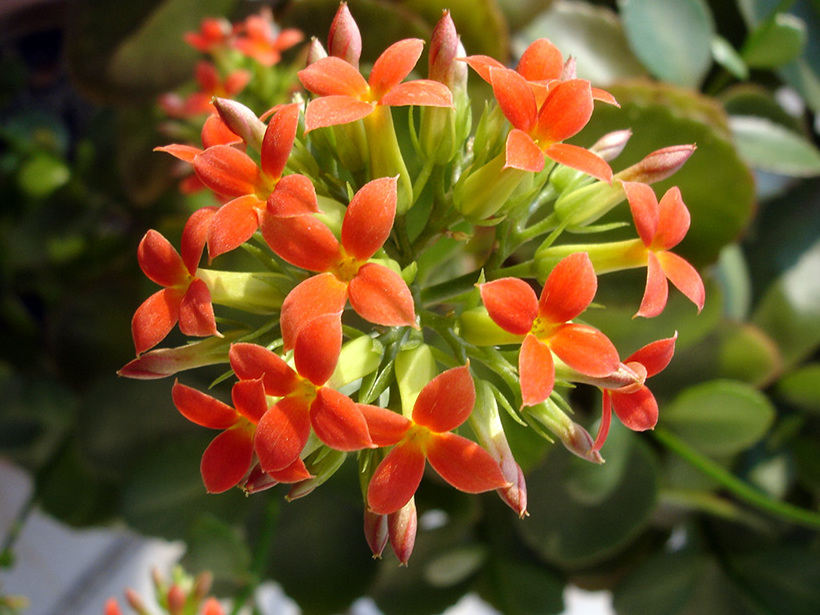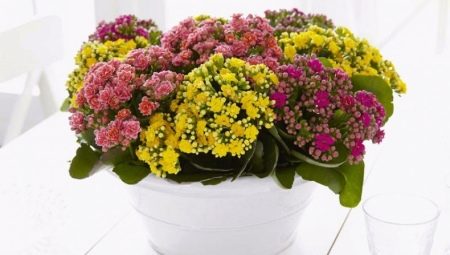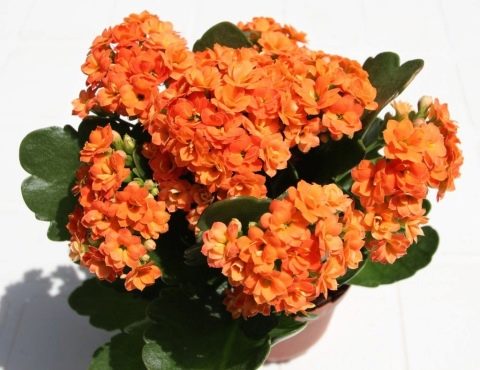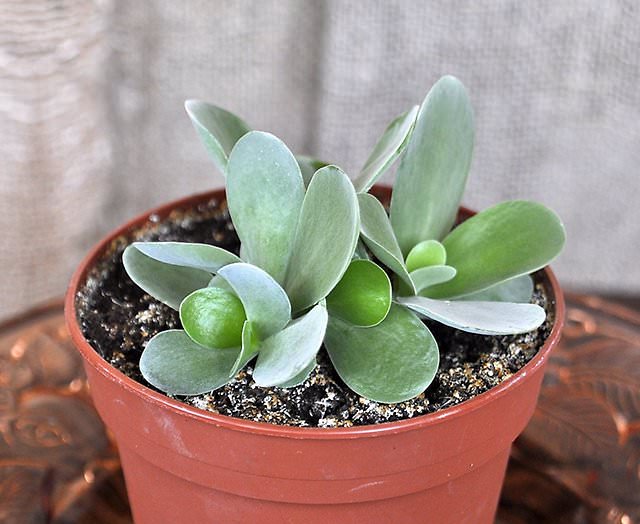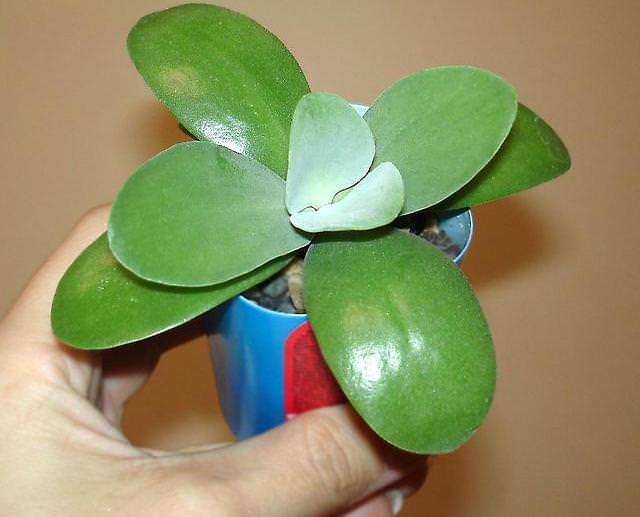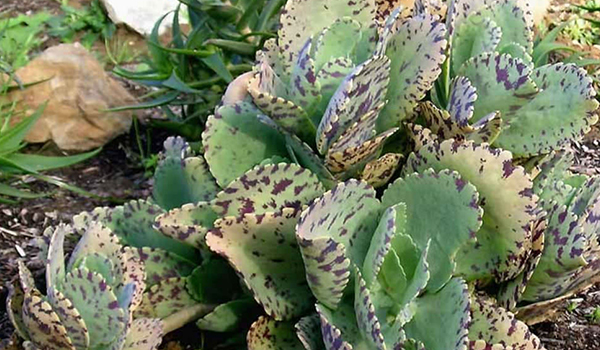Kalanchoe tirsiflora



Specifications: One or more plants in a technical pot with a diameter of 5 cm, without a planter (first photo). The planter can be purchased separately here.
You can also purchase fertilizers and other related products here.
The first photo is REAL and true!
DELIVERY: Pickup (free) or mail. Estimated shipping cost for potted plants ⌀ 5 cm = 150 rubles. + 50 rub. every third plant). The cost of mailing plants in larger pots is calculated individually, depending on the weight and size of the plants.
ATTENTION: Only seeds and product assortment are sent by cash on delivery. Live plants are shipped on a prepaid basis
Usage: Looks great both as an independent plant and in compositions of succulents.
Description: Kalanchoe - succulent plants of the Fat family. There are more than 200 species in nature. The natural habitat for this plant is the tropics and subtropics. For example, it can be found in Africa, New Guinea, Asia, Australia, and also in Madagascar. In Russia, the plant appeared a very long time ago, it is grown as an ornamental-flowering and medicinal one. Among Kalanchoe, there are herbaceous plants (perennials), succulents and shrubs.
The leaves of almost all species of this plant are thick and fleshy, and the stems are both creeping and erect. The height that an adult plant can reach is different for each species. So, there are representatives that can grow up to one and a half meters in height, and there are those whose size does not exceed 20 centimeters. Their flowering is quite long and abundant. Their multi-flowered umbrella-shaped inflorescences are of different colors, for example, white, red, yellow or light pink.
This plant is very unpretentious and very easy to care for. It also very quickly gets used to room conditions. And if you consider that it grows quickly and multiplies easily, then you can understand why the Kalanchoe has gained such popularity among gardeners. The Kalanchoe has many popular names: tree of life, room doctor, room ginseng, they say about him "surgeon without a knife." Its great advantage is that it is completely safe. When it comes to choosing flowers for a child, in a nursery, Kalanchoe fits perfectly.
Kalanchoe panicled flower ' Flapjack ‘ lives on rocky slopes in South Africa. Perennial herbaceous plants up to 60 cm tall, densely leafy. Leaves obovate, up to 15 cm long and 7 cm wide, bluntly rounded, silvery white; lower in the socket, densely located; the upper ones are located less often, smaller than the lower ones. The inflorescence is a panicle. Flowers are yellow; rim tube, jug-like swollen, 4-sided, 1.5 cm long; petals are small, rounded, up to 0.5 cm long. Blooms profusely in April-May. Highly decorative plant. After flowering, the plants form many bulbous buds, which are widely used for plant propagation.
Care: Almost all Kalanchoe species can be grown over a wide temperature range. In summer - within 18-28 ° C, in winter - at least 10-12 ° C, best of all - at 16-18 ° C. At high temperatures in autumn and winter, flower buds do not form. In spring and summer, Kalanchoe is watered moderately, if the plant is kept in the sun, then watered abundantly, as the upper layer of the substrate dries, in winter - much less often, with soft, settled water, but they do not stop watering completely, since when the plants dry out, they greatly lose their leaves. Water can not be poured from the top, but into the sump. Thanks to the fleshy leaves covered with a waxy coating or numerous hairs, all Kalanchoe plants tolerate the arid air of city apartments well. Air humidity does not play a significant role for the plant.Kalanchoe does not require spraying, but on a hot summer day, this can only benefit the plant.
In the summer, mineral fertilizers are applied weekly and organic fertilizers once every 2 weeks. In the fall, when laying the buds, feeding can be repeated. You can feed with fertilizer for cacti. The transplant is carried out as needed (overgrown plants). The soil for replanting is neutral or slightly acidic (pH 5.5-6.5). Plants grow well in the usual mixture for succulents, with the exception of epiphytic species, for which, for abundant flowering, it is advisable to add humus earth and apply fertilizing fertilizers. Young plants are transplanted into a mixture of 4 parts of turf, 2 parts of deciduous land, 1 part of rotted peat and sand. Instead of peat, you can take coniferous soil.
How to choose?
The preference in choosing the right Kalanchoe variety depends entirely on your tastes and the purpose of the purchase. So, all subspecies are decorative and suitable for home cultivation. The only thing to consider is that each species has its own specifics of care, so using a single system for everyone, you risk simply ruining the plant.
To decorate the interior, you can use any variety of Kalanchoe that suits the given style of the situation, and, in addition, according to the teachings of Feng Shui, it is the most noble plant. The best choice for decorating hanging decorative elements will be Kalanchoe mangin. Under the weight of the blossoming buds, its stems tilt downward, forming colorful airy thickets.
If you are a supporter of alternative medicine or a fan of Indian culture, then you should be aware of the role played by the dissected Kalanchoe ("deer horns"). Although, in fact, it does not possess any medicinal properties. The Kalanchoe pumila subspecies has been used in medicine for a very long time and is a recognized source of useful substances, for example, vitamins, minerals, polysaccharides and others.
The plumose Kalanchoe is one of the most famous medicinal subspecies. Helps to cope with indigestion and diseases of the female genital organs, as well as the kidneys and genitourinary system. If necessary, it can be used as a disinfectant and antibacterial agent for open shallow lesions of the upper layers of the skin.
Not recommended for people with heart problems.
German writer Johann Wolfgang Goethe believed that Degremona could help with male diseases. But not only - Degremona is also antimicrobial, anti-inflammatory and healing agent. Kalanchoe Fedchenko is a rather rare, but very beautiful variety. It was used as an antiallergic and healing agent for shallow burns. It is believed that some varieties of Kalanchoe are widely used in cosmetology for the healing of skin surface disorders. And also the plant has long been used as a compress for toothache.
Almost all types of Kalanchoe have healing properties, but to varying degrees - if our grandmothers were still treated with the help of some, then the beneficial properties of others are discovered only in our time. This is not surprising - despite belonging to one large species, each plant has its own unique set of chemicals that can become so necessary for humans.
Diseases and pests
- Lack of light. Remember that the Kalanchoe is home to the hot and humid tropics. This means that a lack of light can lead to leaf fall, their pallor and yellowness.
- If you notice that the leaves begin to fall off and wrinkle, it may be due to a lack of moisture, or that the room is too hot and too dry.
- If you are waiting for flowering, but it never comes, this means that the Kalanchoe has managed to be oversaturated with the applied organic fertilizers. Therefore, stop feeding immediately.
- If, after flowering, you notice that the plant stops growing, this means that it is lacking in nutrients. It is necessary to transplant into a new pot and do not forget about fertilizers.
- Signs of decay on leaves and roots. Unfortunately, this happens if you are experiencing a flower.
Also, there are dangerous pests that seriously harm the plant.
- For example, a scale insect that forms a plaque on the leaves and infects it with a fungus.
- Powdery mildew. Appears in case of waterlogging. To fight, it is necessary to lower the temperature, and also treat it with chemicals.
- Mealybug. One of the most common diseases of this plant. It appears in hairy tangles on the leaves. It is processed with alcohol-containing agents or chemicals.
Varieties of Kalanchoe yellow, pink, white and red
An ornamental flowering perennial belongs to the Fat family, and in natural conditions it is widespread in many countries, including Asia and Africa. To date, many varieties of this plant are known in room culture, which form both ordinary and double-type flowers of bright color. The petals can be yellow or orange, as well as red or delicate pink and pure white and all kinds of shades. The most popular varieties with bright flowers:
- variety "Аmora", widespread in indoor floriculture, with red flowers;
- variety "Alexandra" is characterized by attractive yellow non-double flowers;
- The varietal feature of Kalanchoe "Avalon" is the formation of relatively large inflorescences of delicate pink coloration;
- double-flowered variety "Bardot" is distinguished by long flowering and bright orange-orange inflorescences;
- large-flowered variety "Simone-2000" forms beautiful snow-white inflorescences.

White-flowered varieties "Mie", "Elsa", "Pluto" and "Sora White". Popular pink-flowered varieties "Delia", "Sora", "Dion", "Katerina", "Melanie" and "Gwenn". Highly decorative and popular red-flowered varieties "Cassandra", "Fuego", "Kawi", "Mary" and "Kerr".
Common varieties with yellow and orange flowers are Karen, Fonda, Ingrid, Goldstrike, Naomi, Arina, Nadia-2000, Carmen and Bardot. Varieties and hybrid forms with variable color of petals, including "Don Darcio", are especially popular. Shrub varieties are most often grown in standard flower pots, and a highly decorative ampelous plant is mainly planted in a flowerpot.
Kalanchoe home care
It will not be difficult to keep the Kalanchoe, because it is unpretentious. The plant is photophilous, the bright sun does not greatly affect its growth, and it also feels comfortable with insufficient lighting.
Air temperature
Kalanchoe to air temperature is undemanding 20-24˚С in summer, and 12-15˚С in winter. At high temperatures in winter, kidneys do not appear.
Watering
The plant contains a lot of moisture near the stems and leaves, so if it is not watered, it will not disappear. In spring, summer and until mid-autumn, water the plant a couple of times a week, and less often when the cold comes. Do not water abundantly, because fungal whitening can occur.
Kalanchoe, which have velvety leaves, do not need to be sprayed to avoid getting water on them. Plants with smooth leaves like a warm shower, but rarely to remove dust.
Fertilizer
When flowering, Kalanchoe requires more fertilization than those that do not bloom. From April to September, they are fed once a month with a universal fertilizer. Non-flowering Kalanchoe varieties are fertilized with cactus bait.
Priming
The plant tolerates soil well from turf and leaf, humus and sand should be added in equal parts. Drainage is required at the bottom of the pot.
Transfer
Young plants need to be transplanted every year, when the spring dormant period ends, older ones - after 2-3 years.
Lighting
Good, bright lighting is required for flowering species. In order for the Kalanchoe plant to bloom in winter, it must be kept in a cool place in autumn and winter, and in summer, stay under light for up to 10 hours maximum. The ideal option may be to arrange the flower on the windowsills of windows from the east or west in the warm season, spring to autumn, and in the cool period, the southern window is preferable.
The dried flowering is removed, the stems need to be pruned so that the Kalanchoe has a beautiful decorative appearance.
Kalanchoe reproduction
Kalanchoe plant propagates by cuttings of stems and leaves, babies and seeds. You need to sow seeds in January-March. Young kalanhoichiks sprout at 20-25˚ С. It is best to breed with cuttings, which can be started to root in spring or summer. Before planting, it is advisable to dry them for 1-2 days.
Planted cuttings should be watered very carefully, not covered with either polyethylene or glass
Diseases and pests
The plant gets sick with excessive watering, aphids appear. The plant's residence temperature should not fall below 10 ° C.
Kalanchoe useful properties
Kalanchoe - medicine on the windowsill. A wide range of its applications in obstetric-gynecological, surgical, dental medicine. The plant has anti-inflammatory properties. Able to quickly clean wounds and ulcers. Skin irritation does not occur, toxicity is low. It is used for burns, bedsores, stomatitis, periodontal disease, and also has a good effect on ruptures after childbirth, nipple cracks.
The plant is very popular in cosmetology as a means for rejuvenation.
Use older plants for treatment, and they will bring the best effect for recovery.
Kalanchoe is an indoor doctor, a tree of life, a beneficial and necessary plant.
Common questions about a houseplant
What types of Kalanchoe have medicinal properties?
The most pronounced medicinal properties are possessed by the type of Degremon. But nowhere is it indicated that the rest of the species cannot be used for treatment.
When is the best time to cut and pinch the Kalanchoe?
Pruning is carried out as needed. Deadwood is removed after flowering, and pinching is done when the shoots lose their decorative appearance.
Why doesn't Kalanchoe bloom?
The most common reason for the lack of flowering is inadequate lighting. Another reason may be too large a pot. If these cases are excluded, care should be reviewed and the flower examined for diseases.
Do I need to pinch the Kalanchoe Degremon?
Degremon's look also needs a pinch. Without this procedure, the flower exposes and stretches the stems, which makes it look unkempt and loses its decorative effect.
Kalanchoe is a perennial plant with medicinal properties. It has a fairly developed species diversity. Most species are undemanding to care for and are easy to grow at home.
Requirements
Originally from Madagascar, Kalanchoe in its natural state is found in more desert places, requires bright places with partial shade. Of course, in a sunnier place it will bloom more abundantly (even up to two months), it should be remembered that the flower is quite hardy and will cope with the worst conditions, but this will affect the appearance of the plant. The plant should not be exposed to full, burning sun.
The soil must be well permeable (pH 6.0-6.5). Succulent, does not prefer excess water. The soil should be drained with sand or gravel so that its permeability is at the proper level.
The flower grows well at room temperature, but during the summer season, the indoor temperature should be around 22-25 ° C. In winter, he prefers a cooler place, while the temperature should not fall below 10 ° C.

Kalanchoe: characteristics of popular species and varieties

Because of its unusual shape, the Kalanchoe dissected (lobed) has a very interesting name among the people - "deer horns". The stem grows up to fifty centimeters in length, the dissected leaves are painted in a light green hue. Florists appreciate the plant for its decorative leaves. The dissected Kalanchoe is not picky, it is easy to grow, satisfying the main need for good lighting. This variety cannot boast of having medicinal qualities.

Kalanchoe marble grows naturally in the mountainous regions of Ethiopia. It belongs to semi-shrubs and reaches a height of fifty centimeters. Long leaves, shaped like an egg, become narrower towards the base. The edges of the leaflets are characterized by denticles and grooves. The plant is interesting in the color of the leaves: young specimens are painted green, lilac or brown spots appear on mature leaves on the sides.

Kalanchoe Behar is a variety that came to us from the southern part of the island of Madagascar. It is a powerful and sturdy shrub with developed shoots. Below the shoots are bare, and pubescent on top. The leaves are also pubescent, have whole or slightly serrate edges. Flowers grow small, up to seven millimeters long. The petals have a linear shape, the rim is distinguished by a tube in the form of a jug. The plant has high decorative qualities. It is grown in cool rooms.
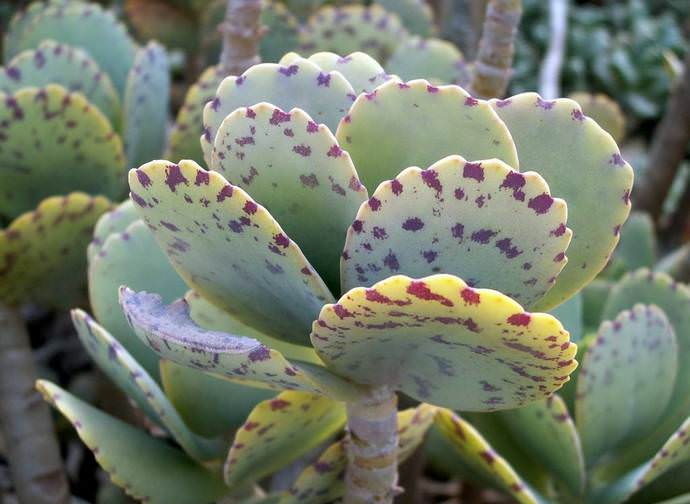
Kalanchoe felt grows naturally in the central part of Madagascar. People call this species "cat ears". It is a semi-shrub with erect shoots with hairs. The elongated leaves take on an ovoid shape, growing up to five to six centimeters in length. The edges of the leaves are intact, sometimes serrate. The inflorescence forms an umbrella. There are many flowers, the plant is highly decorative.

Kalanchoe tubiflora refers to shrubs that can reach a height of seventy centimeters. The long, narrow leaves are gray with a greenish tint and are covered with small brown dots. A large number of buds appear on the upper leaves. Elongated bell-shaped flowers are born on the plant. They can be painted in a variety of colors: bright red, snow white, dark purple, pinkish, rich yellow and purple.

- Kalanchoe serrata resembles a plant species called Kalanchoe degremona. This species is distinguished by small leaves and shortened internodes. The edges of the leaves are covered with a large number of teeth, which provides the baby with a closer fit to the mother plant. Breeders have developed an unusual plant variety that lacks chlorophyll. It is pink in color and attracts hobbyists when brood buds appear.
- Kalanchoe Madagascar is the only ampelous variety. It is distinguished by gracefully flowing thin shoots. Rounded leaves are opposite. The flowers are orange and red with a beige tint. They grow at the ends of the shoots and, hanging smoothly, form beautiful clusters.

Kalanchoe fiery in the wild is found in the vast rocky terrain of Somalia. It is a perennial herbaceous variety, not highly branched. Rounded leaves taper at the base and are serrate. The flowers, collected in an umbrella-shaped inflorescence, are painted in a bright red color, hence the name of the variety.

Flower growers fell in love with Kalanchoe not only for its high decorative qualities, but also for important healing properties. Among other things, Kalanchoe effectively purifies the air, has a beneficial effect on a person's sleep, making him strong and healthy, improves mood, provides energy and strength for the whole working day.
Application of Kalanchoe leaves
The use of Kalanchoe leaves is not at all difficult. Cut the leaves off and rinse in water, let the water drain. Then wrap the leaves in newspaper and put in the refrigerator for a week. After the lapse of time, the leaves need to be crushed, it is advisable to do it by hand. When the Kalanchoe is crushed, we put it on cheesecloth, which must be folded in four and squeeze out the juice. Put the finished juice in the refrigerator for a day to precipitate. Strain the juice through cheesecloth and transfer to a dark jar. Store no more than two weeks.
Kalanchoe infusion on alcohol
You can prepare a tincture for this you need to take one part of the juice and five parts of 70 percent alcohol. drain into a dark bottle and close tightly. The shelf life is no more than a year. During the flu, use Kalanchoe juice for prevention. For children it needs to be diluted with water one in five, for adults it should be used without dilution. It is necessary to lubricate or bury it in the nose. If you have a runny nose, rinse your nose and drip the diluted juice as soon as there is nasal congestion.
If you wish, you can prepare an ointment. To do this, pour thirty grams of Kalanchoe juice into a container, add fifty grams of lanolin, you can buy it at a pharmacy. You can use pork fat or goose fat, some use top quality butter. Heat until completely dissolved, not allowing it to boil. Refrigerate after cooling.
The ointment is used for eczema, purulent wounds, psoriasis. Also used for bedsores, skin rashes, frostbite.
Kalanchoe water infusion
Kalanchoe is crushed and placed in a container, filled with water and placed in a water bath for twenty minutes. If the infusion is applied externally, take one part of Kalanchoe and five parts of water. For indoor use, the ratio is one to ten. Then the broth is filtered. The broth is filtered and boiled until it is halved.
Used in the treatment of tuberculosis, in gynecology, for diseases of the digestive system.
There is an opinion among the people that the Kalanchoe cleans the air in the room from bacteria and viruses. Brings peace and tranquility to the house.

Kalanchoe Blossfeld
This type of Kalanchoe is one of the most popular home-grown plants. He was loved for his undemanding care and beautiful appearance. Such a bush grows to a height of 40 cm, has a very compact shape and a wide range of flower colors. In addition, its leaves have healing properties that are used in folk medicine for wound healing and as an anti-inflammatory agent. Begging for such a plant will not give you much trouble. It should only be periodically fertilized, pruned and moistened. This species also accumulates moisture in its leaves and can tolerate periods of drought well. Growing in a place with diffused sunlight, Kalanchoe will delight you with flowers for a long period. In the nature of Madagascar, where this Kalanchoe comes from, it is found only with red or orange flowers. However, on their basis, many varieties were bred with a multi-colored color. In order to obtain abundant flowering, experienced flower growers are advised to cut the flower stalks immediately after the flowering period. This procedure stimulates the formation of buds for subsequent flowering. When the Kalanchoe completely re-blooms, it is trimmed to the first leaves and the watering periods are shortened. This will provoke the formation of new buds and the fastest subsequent flowering.

Felt (tomentose)
The felt Kalanchoe has fancy velvety leaves, similar to the ears of a plush rabbit. Their color is greenish-gray with a brownish edging along the edge of the leaf. The entire bush is covered from top to bottom with the finest fluff, even flowers.

Under natural conditions, it can grow up to a meter in height, and at home - no more than 40-45 centimeters.
Kalanchoe luciae (Lucia)
This type of Kalanchoe grows a little more than half a meter, and is very similar to paniculate-flowered.Their basal rosettes are uniformly formed, and the densely packed oval, green leaf plates seem to be powdered with white powder.
From the cold and from the bright sun, Lucia's leaves acquire a red hue, and may even become red-burgundy.

The main difference appears during flowering. The white flowers of Lucia have a faint aroma, while the paniculate flowers are yellow with a bright aroma.
Kalanchoe fedtschenkoi
Kalanchoe Fedchenko is a bryophyllum. His height is a little more than half a meter. The leaf plates are oval in shape and have a fleshy structure. Their color is pale green with a blue tint, and a pink border runs along the wavy edge. In dry times and from the scorching sun, the leaves can completely turn red.

Kalanchoe Fedchenko blooms with orange bell flowers of various shades, throwing out a long peduncle in the form of an arrow from the center of the bowl.
Gastonis-Bonnieri
This type of succulent belongs to bryophyllums, grows up to 45 centimeters in height. At the same time, it can look just huge, thanks to the lanceolate leaves, which sometimes grow up to half a meter.

The leaf plates are light green in color, powdered on top with a powdery bloom. Small brown blotches and a dark edge along the corrugated leaf make the bush very decorative. Children grow along the edge, forming ready-made small Kalanchoe.
In early autumn, the Kalanchoe throws out a flower arrow, which sometimes reaches 90 centimeters. At the top of the peduncle, lush burgundy-red inflorescences of tubular bells are formed, painted along the edges in light yellow tones.
Diseases and pests
The disease can provoke not only a parasite but also improper care.
Late blight rot - the reason for its appearance is excessive watering and poor ventilation, this is indicated by dark spots on the leaves and brown bloom. In this case, treat the bush with fungicides, reconsider the frequency of watering and fertilization.
When a ring spot appears on the leaves and the stem begins to rot, it means that the flower has caught a dangerous virus and cannot be saved in any way.
Blackening stem or trunk are symptoms of hypothermia
It is important to prevent fungus from appearing when watering, especially during the winter months.
A dangerous parasite of Kalanchoe Mix is a mealybug, they get rid of it by wiping the leaves with a cotton swab dipped in alcohol.
Beware of parasites that can live nearby on other houseplants such as aphids, scale insects, and spider mites.
In case of minor damage, they can be removed with a damp cloth, but in a serious case, you will have to use a special pesticide.
- When buying, be sure to check the flower for plaque, inspect the back of the leaves.
- After cultivation, change the land to fresh.
- Diseased dry leaves should be removed.
- Try to provide good ventilation in the room, the flower loves freshness.
- As a preventive measure, spray with soapy water from time to time.
Kalanchoe Kalandiva
A marvelous species with a gorgeous name Kalandiva was born to a Swedish breeder. He noticed that flowers of an unusual purple hue appeared on the Blossfeld Kalanchoe bush. The appearance of a purple flower on a plant with a certain color scheme, which does not have purple shades in its set, is already an event, but the special admiration was caused by the fact that the shape of the flower was different.

The flower of the Kalanchoe Blossfeld, which makes up the cluster of the inflorescence, has 4 petals, and in this mutant the flower consisted of several petals, like a rose, the breeder counted as many as 32 petals. The inflorescence was beautiful, dense and resembled a ball, not a brush.
These are the pirouettes Mother Nature gives out to people who passionately love their work. The breeder looked forward to re-flowering to ensure that the traits of the new strain would reappear.And lo and behold, thanks to the creator, the unusual plant again threw out flowers, similar to bunches of small roses.
So in 2002, as a result of the work of producers and breeders, a new type of Kalanchoe Kalandiva appeared on the shelves of flower shops, with genetically fixed features of the flower shape and color palette.

How wonderful that the breeding work does not stop, and now you can admire such beauty with beautiful names.
What to do to make the Kalanchoe bloom
If your plant does not bloom, provided that you have properly looked after and maintained it, then try to reduce the amount of fertilizer applied to the soil. The fertilizer application must be suspended, gradually reducing the amount. The most famous reason for not blooming Kalanchoe is the high content of fertilizers in the ground. The inflorescences must be removed as soon as the flowers wither. If pruned in time, this will awaken new flowering stems and extend flowering until mid-summer. Kalanchoe refers to re-blooming, but this is not so easy to achieve, and therefore it is often thrown away as soon as the flower has faded.
Tubular variety

Next, we will consider another bryophyllum (viviparous flower), namely the Kalanchoe tubule. It has only one thick central trunk that can grow up to 1 meter in height. All leaves are located around the stem. They have edges wrapped inward, and due to their long size, from a distance, they can resemble tubes, which remain hollow inside and slightly raised upward, which gave the distinctive name to the variety. The color of the leaves themselves, like the stem, are violet-green with an obligatory bloom of gray. Quite often, you can see various dots and strokes of purple and brown shades on the leaves. Flowers are arranged in panicles and are red or orange.
Optimal conditions for growing a plant at home
In general, the Kalanchoe is not a picky plant at all, so it is easy and pleasant to take care of it. However, if the florist is interested in creating the most comfortable conditions for his growth and long flowering, then he should follow several important rules.
Lighting
The flower will take root perfectly in a place where there is a lot of light. However, it is better not to leave the plant under the scorching rays of the midday summer sun in order to avoid leaf disease, but in winter, the pot with Kalanchoe should be rearranged to the south side of the house - this way the plant will compensate for the lack of sun. The rest of the time, the flower can be placed in the west or east of the apartment.
Temperature conditions
The home doctor perfectly tolerates the heat - he is no stranger to high marks on the thermometer. As for the winter season, for the early laying of flower buds during the dormant period, the temperature should be maintained at + 17-18 ° C. At low temperatures, there is also no need to fear for the life of a home doctor: the plant can withstand temperatures as low as + 5 ° C.

Kalanchoe will perfectly take root in a place where there is a lot of light
Humidity
Moisture indicators are the least important condition in the care of the Kalanchoe, since the plant successfully develops with almost any degree of air humidification. However, it can sometimes be sprayed and wiped with a soft cloth or sponge for hygienic purposes.
Substrate
For Kalanchoe, as for a succulent, you need a drained soil, in which leafy soil, turf, peat, and sand are present in proportions of 2: 4: 1: 1 with the addition of humus. If desired, the mixture can be purchased at specialized stores.

To maintain the high shape and decorative properties of the Kalanchoe bush, it is recommended to annually prune and pinch the regrown shoots
Watering and feeding
It is recommended to feed the Tree of Life twice a month in May-July and November with fertilizer for cacti.In the absence of the latter, you can take any fertilizer for ornamental indoor plants and measure out half of the norm. Experienced flower growers strongly recommend feeding the Kalanchoe immediately after flowering and avoiding the use of fertilizers in winter.
Transfer
It is necessary to transplant Kalanchoe if the adult plant becomes cramped in the old container, or if the quality of the substrate has decreased as a result of frequent watering. Young flowers are recommended by flower growers every year in late spring.
Pruning
To maintain the high shape and decorative properties of the Kalanchoe bush, it is recommended to annually prune and pinch the regrown shoots. Pruning is done in spring and pinching in early summer.
Prevention of diseases and pests
In case of damage to the plant with powdery mildew or gray rot due to waterlogging, it is necessary to treat the leaves of the flower with special preparations. You should also be attentive to various kinds of spots on foliage and small insects. The main enemies of the Kalanchoe are aphids, ticks, worms and scale insects. To fight parasites, radical pruning of the stems and treatment with insecticides or an alcohol solution will help.

It is recommended to feed the Tree of Life twice a month in May-July and November with fertilizer for cacti.





